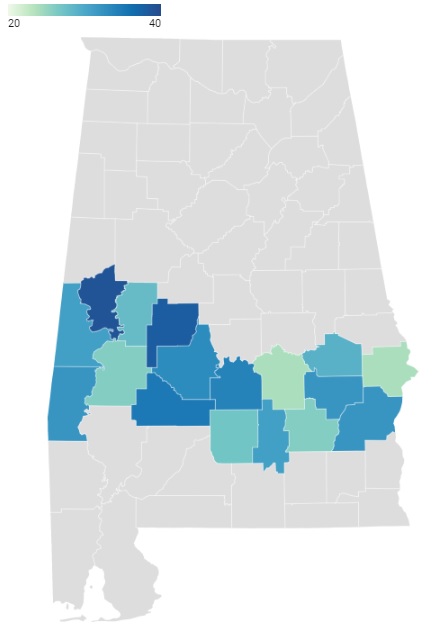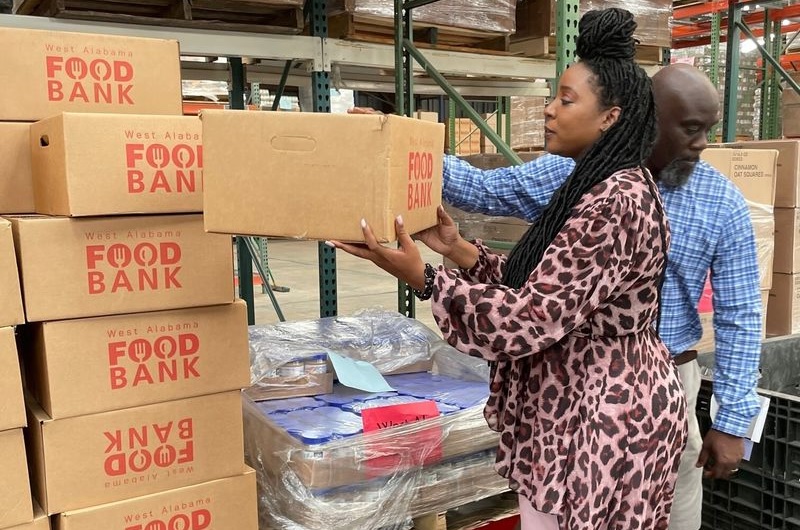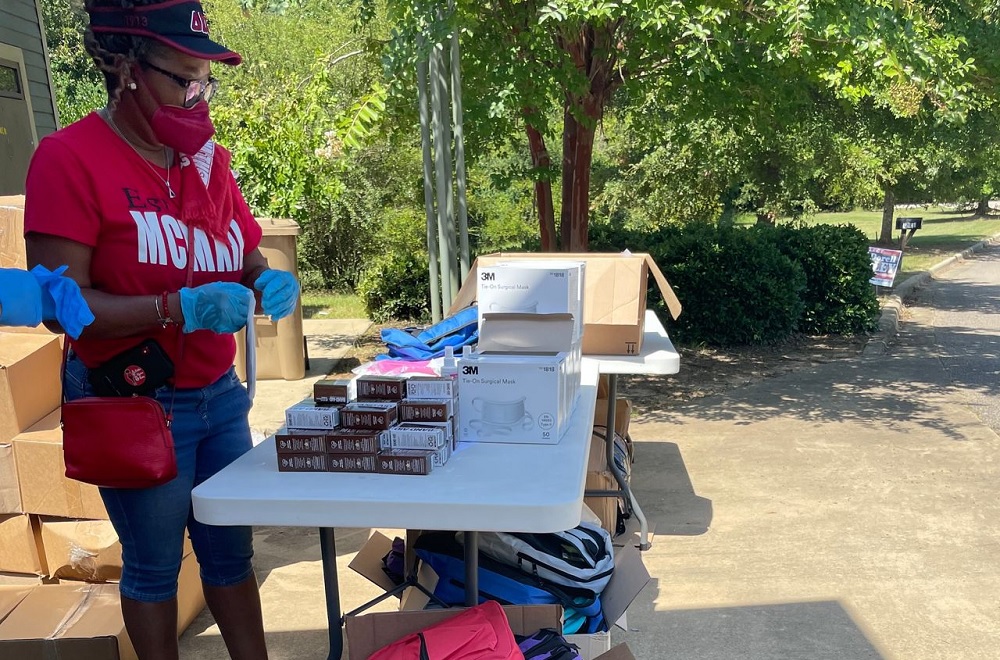Angela Pettway drives 90 miles round trip to the grocery store almost every day.
Food runs out quickly in her rural Alabama household. She homeschools two of her children and feeds them all three meals. She also helps care for her dad. More and more recently, neighbors have been coming over to ask if she has any food to spare.
“Do you know how many people come to me and ask ‘did you cook today? Can I have a plate?” said Pettway. “It’s hard for me to give food as well, but my heart is not like that so I squeeze a little bit out because I don’t know where my blessing is going to come from. I don’t know if one day I’m going to go to that same person and ask them to feed me.”
Pettway lives in Gee’s Bend, a town surrounded on three sides by the Alabama River. The median income of the community is $16,023, more than half that of the county, Wilcox, which is itself one of the poorest in the state.
There is a ferry intended to get residents across the river to Camden, the county seat. In 1962, as residents of Gee’s Bend, whom are nearly all Black, tried to vote, it closed. The ferry reopened in 2006, again turning the journey into an faster trip — but is often decommissioned with mechanical issues, according to Pettway, leaving her neighbors still largely isolated.
So she usually drives her truck to the store, filling up on gas on every trip. There’s a convenience store in town, but because it’s the only option, prices there are triple elsewhere. The last time she forgot eggs to make her neighbor mac and cheese, a dozen cost her nearly $5 at the local shop.
“Lord, please never let me forget eggs again,” she lamented.
A history of disinvestment and exploitation have left this region of the state, called the Black Belt, a food desert – an area with limited access to affordable and nutritious food. And the children who live there are often most impacted.
“In 1967 the President’s National Advisory Committee on Rural Poverty called the citizens of the Black Belt a people left behind,” said Brandon Renfroe, who researched food insecurity at University of West Alabama. “And here we are decades later and poverty and food insecurity have just converged in this region, which says they are still being forgotten.”
Impact on children
The Black Belt originally got its name for the dark, fertile soil that made this region of Alabama a hub of cotton production and therefore slavery, with one of the highest concentrations of enslaved Black folks in the South.
Today, the name refers to the majority Black population that live there, people who can mostly still trace their ancestors back to the plantations.
But over the past century, local food production has decreased, with many farmers aging out of the profession, being priced out, or affected by severe soil erosion.
Rural communities have been hit hardest by inflation, according to recent research by the University of Iowa. Residents must drive further for essential services, costing more in gas. Once at the grocery store, the price of food is typically higher because of the higher cost to ship products to remote areas. Alabama is also one of 11 states to add a tax to groceries, and one of only three to not offer a tax credit or rebate to low-income households.
Child food insecurity in the Black Belt

Ruth Serven Smith/AL.com
Children in Alabama’s Black Belt region have high rates of hunger, malnutrition and childhood diabetes. National nonprofit Feeding America estimated the rate of food insecurity in Alabama to be 23% in 2018, the most recent year available. The organization defines food insecurity as the lack of the lack of access, at times, to enough food for an active, healthy life.
The pandemic has driven up rates of childhood food insecurity nationwide, with the percentage nearly doubling in October 2020 as compared to the previous year.
The Household Food Security Survey has been administered by the United States Department of Agriculture annually since 1995 by asking questions like whether participants worried about running out of food and not having money to buy more. Across the U.S., 7% of households with children report food insecurity. Less than 1% of children are estimated to live with very low food security.
But researchers have found that parents, who typically fill out the survey, underreport food insecurity in their children, missing as much as 50% of children who would themselves report being food insecure.
Last year, Renfroe at the University of West Alabama undertook one of the largest known efforts in the country to assess child food insecurity by asking teenagers to take a version of the Household Food Security Survey created by the USDA specifically for youth.
“Food insecurity is measured nationally from a parent perspective, but we didn’t have a lot of data where the children report their own experience even though studies have shown they are reliable reporters of their own experience,” said Renfroe.
Renfroe administered the survey to 742 students in 16 Black Belt high schools.
The study found that a quarter of the students self-reported as experiencing food insecurity, with about 9% facing very low food security – meaning food has run out and they’ve gone a day or more without eating – far exceeding the national average.
‘Community taking care of the community’
Throughout the Black Belt, schools have been an oasis in a food desert.
“Schools play one of the biggest roles in combating food insecurity,” said Heather Shambry, the Child Nutrition Program director for Sumter County Schools.
During the pandemic, the importance of school meals was highlighted, as need increased and it became more difficult to get two meals a day directly to students.
Black Belt CNP directors worked together to ensure their students were fed, often calling one another for advice or to strategize how to get meals to students in more remote locations. Shambry and her staff created bus routes for drivers and central office staff to hand out meals everyday while students were learning virtually.
“As we went into the community, we saw the need and prevalence of food insecurity more clearly than we were able to when students were in school,” said Shambry, who described seeing poor living conditions and meeting parents who were grateful for the service her and her staff were providing.
While many schools are dealing with the end of universal free meals – a pandemic program that gave students nationwide free school meals without application or income requirements – most school districts in the Black Belt have programs in place that provide a similar service. Sumter County has used a federal program called Community Eligibility Provision to provide free meals to all students since 2018.
Districts with 40% or more of their students eligible for free and reduced price meals and a high level of participation from students in school meal programs are able to apply for CEP by Sept. 30.

Savannah Tryens-Fernandes/AL.com
Heather Shambry, CNP Director of Sumter County, and Sheldrick McNeal Jr, chief operating officer of the West Alabama Food Bank, pack food items for weekend backpack meals Aug. 1, 2022, in Tuscaloosa, Alabama.
Now, Shambry’s focus is to help provide free meals to students who need it most over the weekend, in partnership with the West Alabama Food Bank.
The program, called Secret Meals, provides enough food to feed one child every weekend for an entire school year. Other districts within the Black Belt have also established a secret meals program in their schools. No Kid Hungry, a national campaign to end child hunger, last year gave nine Black Belt school districts a combined total of over $250,000 to get the programs started, as well as to address other needs like new kitchen equipment or bonuses for CNP staff.
The West Alabama Food Bank has calculated that it costs $140 to feed one child for every weekend during the school year. They’ve partnered with corporations in many Black Belt counties to help fund these programs. So far, Sumter County has raised over $3000 – enough to feed 21 kids.
“This is the community taking care of the community,” said Jean Rykaczweski, director of the food bank.
Her staff has begun preparing for an influx of need this year due to inflation and the end of universal meals. Volunteers from sororities at nearby University of Alabama often help pack backpack meals, as well as groups from the Mercedes plant just a few miles down the road.
Shambry comes to the Tuscaloosa-based food bank once a week to pick up the meals that she then distributes to selected students.
The backpacks typically include non-perishables and healthier options like raisins, cornflakes, granola bars and juices.
“We wish we could give this to every kid,” said Shambry of the program, but funding is still lacking, and would cost about $165,000 to feed all of the district’s students.
Rykaczweski is working to develop more meaningful relationships with corporations like Alabama Credit and Cahaba Medical to help ensure these programs are lasting and consistent, instead of relying on annual donations.
“If we can make the community invest in children, we can change those communities so they don’t have to rely on grants and one-time donations that are not sustainable,” said Rykaczweski.
The Carver Integrative Sustainability Center at Tuskegee University, located in the Black Belt, is also working to provide community-led and maintained solutions to address food insecurity in the region.
“We are addressing community economic development through a food systems approach,” said Raymon Shange, director of CISC and associate professor of environmental and agricultural sciences at Tuskegee. “We look at how we can assist in bringing in businesses, food businesses, increasing the number of farmers that we have here that we think will actually have a compounded positive impact on the economic system, the school systems, etc.”
Shange and his team have implemented a variety of programs throughout the region, including pairing high schoolers and college students from the Black Belt with local, Black farmers who can mentor them and teach them to run a farm. They also have built greenhouses and gardens in public K-12 schools throughout the region so kids can learn to grow and cook their own food.
“I don’t think it’s possible to do a top-down solution for local food insecurity,” said Shange. “There’s going to have to be some investment of time, of money, of people…but communities are ultimately going to be responsible for their own progress.”
‘Come together’
In early August, Pettway gathered with other members of her community outside the Boykin Nutrition Center.
A group of volunteer medical professionals and members of Greater Shiloh Baptist Church drove down from Birmingham to provide free medical screenings, back to school supplies and food boxes.
The mission, called A Promise to Help, was started by Dr. Sandra Ford and her husband, Henry Ford, both of whom grew up in the region. The organization has gone to a Black Belt community on the first Saturday of every month for 20 years.
Today, the Fords see a higher need for food from the people who visit their clinic, as well as high rates of diabetes and childhood obesity caused by not having access to healthy food.
While the state does not collect juvenile diabetes statistics on a county level, residents of the Black Belt have traditionally had some of the highest rates of diabetes in the country due to a combination of factors, including genetics and living in an economically underdeveloped region.
Doctors at the University of Alabama at Birmingham have found that rates of juvenile diabetes statewide have rapidly increased during the pandemic. Between April and November 2020, there was a 205% increase in type 2 diabetes diagnoses in kids, as compared to those same months in 2019.
“Patients who live in food deserts do not have good options for healthy eating nor can they afford them depending on their family’s finances,” said Dr. Mary Scott, associate professor of pediatric endocrinology and diabetes at UAB. “A lot of people buy groceries at quick stop type places, Dollar General type places, and just don’t really have the finances or potentially in some cases the knowledge about healthy eating that can help prevent earlier diagnosis with type two.”
For the Fords, a recent trip to Lowndes County, where they saw the local grocery store had been replaced by a Dollar General, was the catalyst to start providing food boxes during their medical missions.
“We started talking to a group of men and telling them to come down but they just weren’t interested in the clinic. But when I said we got free food, one of the guys took off toward it, saying he was starving. I said to the other guys, wow he really is hungry, and they said we all are, we don’t even have a grocery store anymore,” said Henry Ford.
At the nutrition center, Pettway took a food box for her family. It contains non-perishables like cans of beans, Chef Boyardee products, bags of rice, peanut butter, preserves and mashed potato mix. Just a few days ago she picked up a box just like it from a co-op in Selma.
As Pettway waits for essential services and sustainable systems to reach her community, she’ll continue to help people while she can, and take what help she can get.
“One minute you could have everything you need and the next it’s gone,” she said. “This time that we’re living in, it’s insane. We’ve got to come together as a community and I’m trying to give the little bit I can.”
***
This story was originally published on AL.com.
Savannah Tryens-Fernandes is a member of The Alabama Education Lab team at AL.com. Her position is supported through a partnership with Report for America.
































